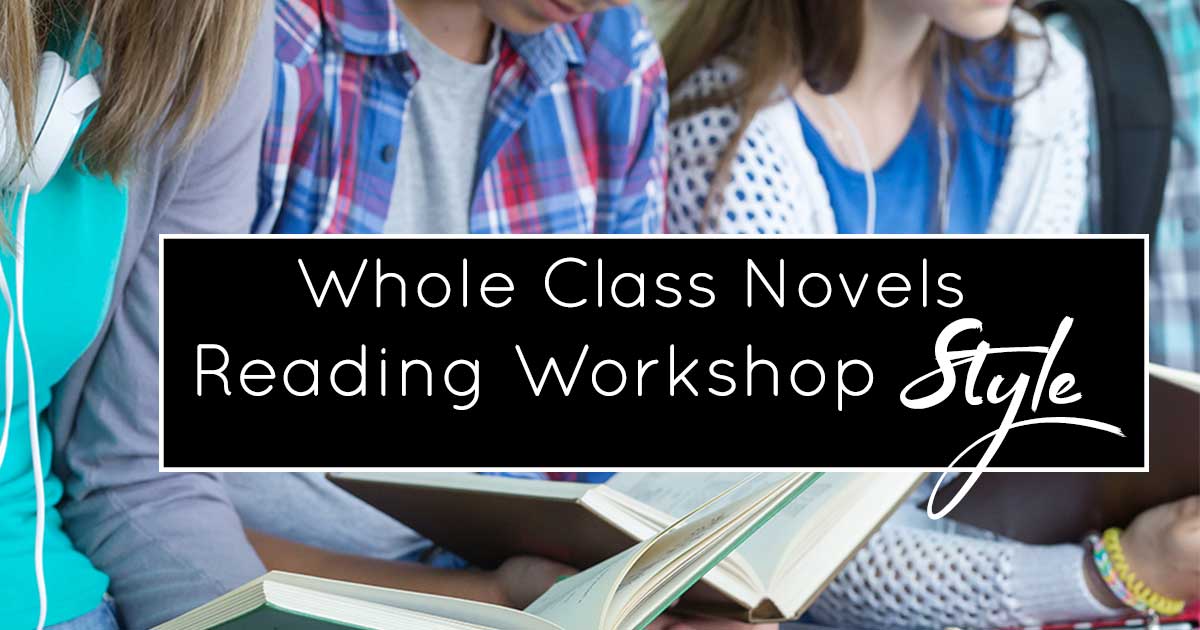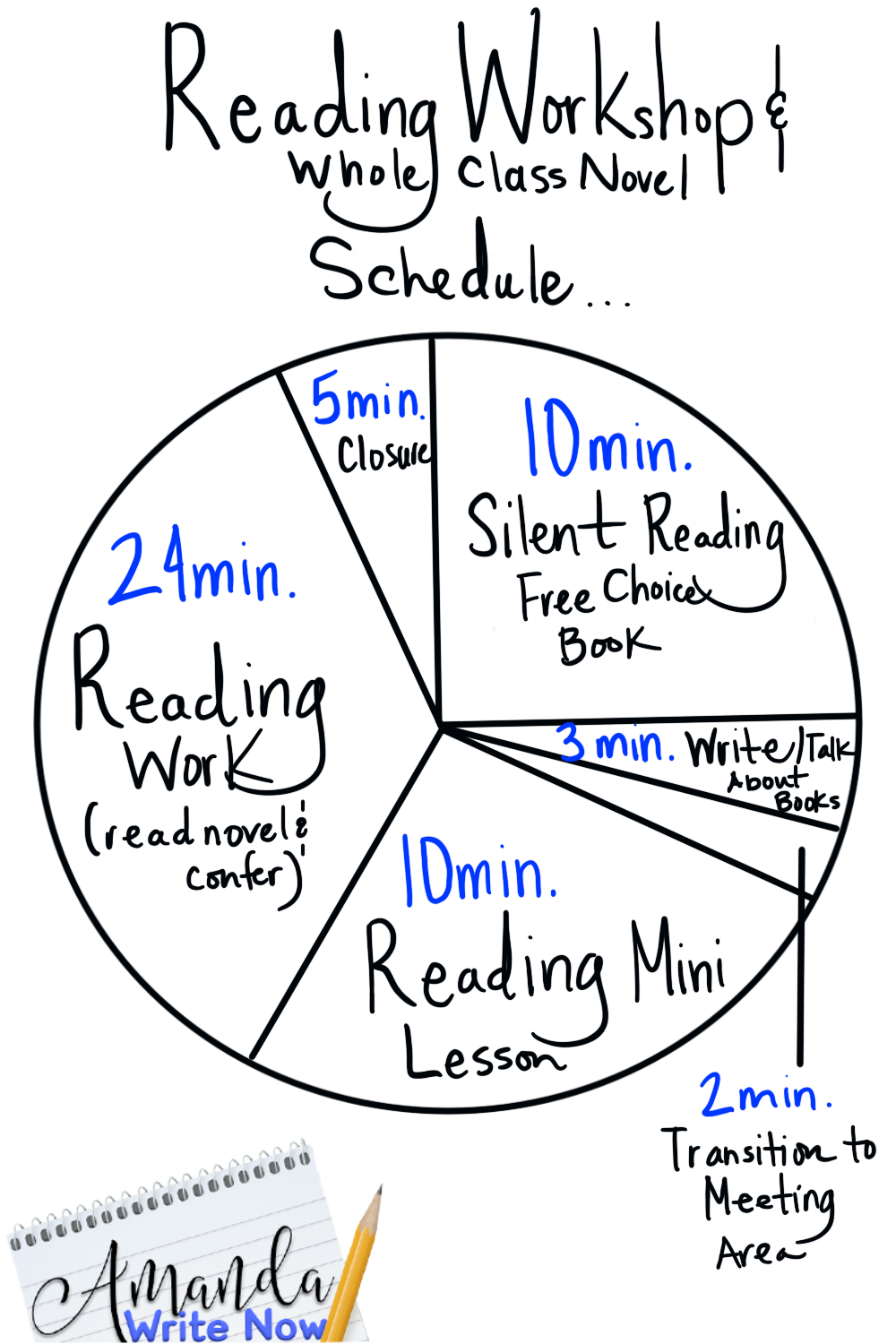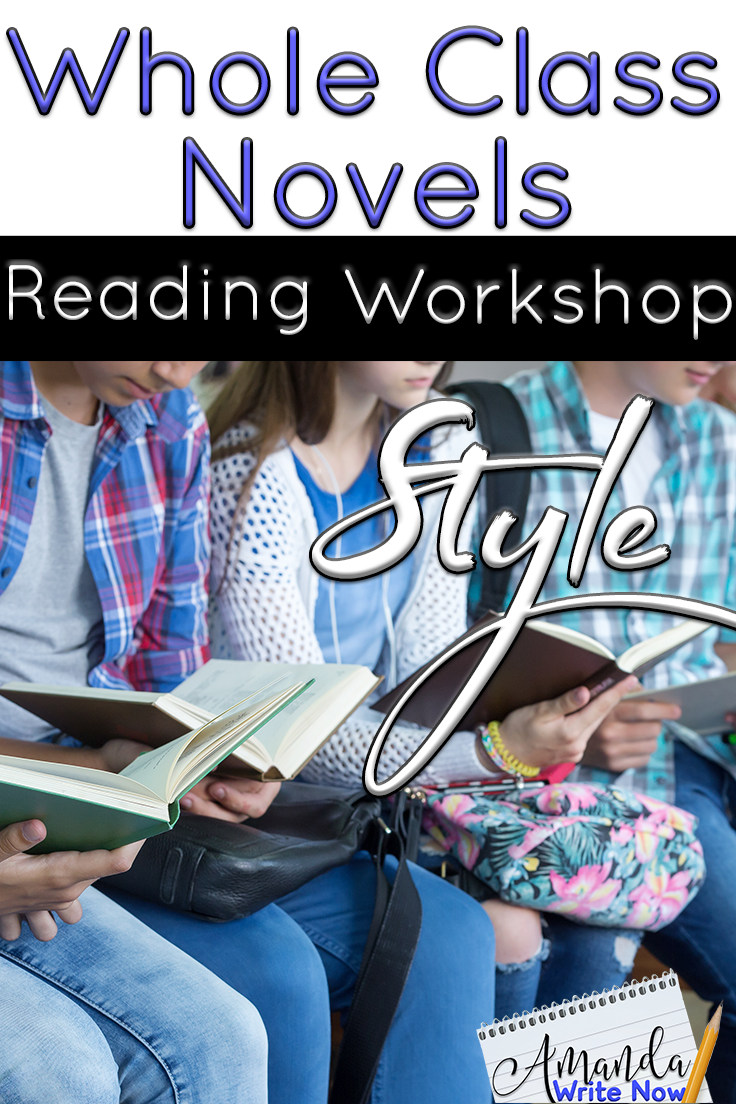
English teachers struggle to fit it all in. We want to teach the novels we love while also allowing the freedom and choice that reading workshop provides. Can we do both? Yes! Keep reading to find out how…First a bit of background about my interpretation of what reading workshop and whole class novel teaching looks like:
A Reading Workshop System Looks Like…
If you are implementing reading workshop, students choose the books they want to read the majority of the time. You or your students might do book talks to entice the class to read certain genres. You might also display themed books in your class library at different times throughout the year. In a reading workshop program students write about and discuss their choice books and the teacher teaches mini lessons like the ones listed at the end of this page.
A Whole Class Novel System Looks Like…
If you are implementing whole class novels, the teacher chooses the novel and students participate in teacher directed activities before, during and after reading the novel. Students also write, discuss and take notes about the class novel. In the book, Whole Novels for the Whole Class: A Student-Centered Approach by Ariel Sacks (Amazon Affiliate Link) students are given a calendar and a deadline for when their book needs to be finished. Then students choose how much they will read each day. Some voracious readers may consume the book in a matter of days, while other readers may break it down into reasonable chunks day by day. Ariel Sacks also has students do mini projects throughout the unit so students have a chance to analyze aspects of the novel more deeply.
Now, here’s the step by step break down of how you could be teaching a whole novel AND implementing the workshop model…
Consider Your Schedule
If you read, How I Teach Reading and Writing Workshop in 54 Minutes, I discuss this schedule break down when teaching a writing workshop unit:
Silent Reading- allow students to read choice books, you could read your own book, take attendance or even conference with a few students during this time
Book Talk- share an excerpt from a book with your class to entice them to read a certain genre or have a student share about a book they currently finished
Transition- have students come to the meeting area (I have students gather around, sitting on tables and a rug, students who are already sitting in desks close to the meeting area stay where they are)

Writing Mini Lesson- teach a short mini lesson related to whatever writing unit you are teaching
Writing Work Time-students write within the genre you are teaching while you confer with as many students as you can
Closure- share student writing either in pairs, groups or with the whole class
In order to implement reading workshop and a whole class novel, your schedule could look more like this:

Silent Reading- of choice books (choice is so, so important when implementing reading workshop)
Write- about choice books/free write/write next to a mentor text, article or poem (some of these ideas were inspired by 180 Days by Kelly Gallagher and Penny Kittle)
Transition- to the meeting area (same as above)
Reading Mini Lesson About Whole Class Novel-
you could teach about theme, character development, setting, plot, note-taking strategies, mood, tone, literary devices etc. you could also analyze excerpts from the novel together as a class
Reading Work Time- read whole class novel independently, with partners or listen to audio version, during this time you should definitely be checking in with your readers (conferring) and how they are doing with the novel
Closure- discuss progress on whole class novel in groups or as a class; save juicy discussions until after everyone has finished the book
So now that you know you can allow students choice in what they read AND teach a whole novel let’s get into planning the whole novel unit!
Choose an Engaging Book
I love historical fiction and believe this genre is often left undiscovered by students without the nudging of a teacher. I’m a huge Laurie Halse Anderson fan and luckily my teaching team reads Chains each year. There are many other books that I’ve read with students over the course of my career, some of them include: Hatchet by Gary Paulsen, Harry Potter & the Sorcerer’s Stone by J.K. Rowling, The Witches by Roald Dahl (I love reading excerpts from this aloud to students in October), Blood on the River by Lynn Carbone and Holes by Louis Sachar. Just make sure that whatever you pick, it is accessible to the average reader at your grade level and that you believe students will be engaged in reading independently during “work time” and sometimes at home if they get behind.
Decide on Mini Lessons
When teaching a novel there are many goals to choose from and those goals should also connect to the culminating event discussed at the end of this article. Here are a few of the goals that you might consider having while teaching a novel…
- Track a character’s development over the course of the novel.
- Track figurative language and literary devices over the course of the novel.
- Write thoughtfully and with evidence from the text about specific literary devices/author’s craft moves used in the novel.
- Write a review about the novel and publish it online.
- Discuss the plot and pose higher level thinking questions to peers.
- Discuss the plot and answer higher level thinking questions.
- Write thoughtfully and with evidence from the text about the mood or tone of the novel. Here’s a video that can help with that…
Conference
You might be wondering what the teacher does during all this reading time? Conferring! You should be asking students questions like:
- How’s the book going for you?
- What are you noticing so far?
- What questions do you have?
- How are you tracking your thinking?
- What literary devices have you noticed?
Conferring can be the toughest part of running a successful workshop program. It is essential that strong management is in place or students will struggle to work independently while you confer. Read this article for advice about conferring with your students.
Facilitate Discussions
After reading Whole Novels for the Whole Class: A Student-Centered Approach by Ariel Sacks (Amazon Affiliate Link) I realized that discussions should be kept to a minimum until everyone has finished the book. Why? So students can enjoy the book without getting hung up on who might be spoiling what for who!
I love Sacks’ idea about providing students with a three week calendar and allowing them to fill it in as they see fit to get the reading done by a designated date! So, what do students discuss during the three weeks they are reading the novel? Whole Novels for the Whole Class is jam packed with brilliant “mini projects” to get kids analyzing aspects of the book such as the setting, characters, theme, symbols etc. So there is some discussion going on, but only to accomplish mini projects along the way rather than to discuss the book so far, without even knowing how it ends, how awkward, right?!?
Write, Write, Write
Students need time to reflect about what they are reading, especially if you are planning to have them write literary essays as a culminating event. They can do this reflection in a notebook during “free write time” or during “work time” listed in the reading workshop schedule above. You can provide guiding questions for students as they write about the novel:
- Describe the main character, how are they similar and different from you? What motivates them? What do they want? How do they change throughout the book?
- Describe the setting of the novel. How does the setting lead to conflict or propel the story forward? Why do you think the author chose this setting?
- What is the bigger picture? Why do you think the author wrote this book? What is the author trying to get across to readers? How do you know?
Decide on a Culminating Event
Your culminating event is what students do at the end of your unit. There are many things students should be able to accomplish after reading a novel. Here are some ideas:
- Write a literary essay.
- Participate in a Socratic Seminar.
- Participate in an online discussion using Google Classroom and shared Docs.
- Act out scenes from the novel.
- Write a book review on Goodreads.
- Write a letter to the author.
Wrap Up
As you can see reading workshop and teaching whole class novels do not have to be mutually exclusive. Each method of teaching reading has its benefits. I don’t believe that English teachers should throw either method out, rather we should attempt to diversify the way we go about teaching reading, we should be risk takers! Rather than teaching one whole class novel after another, English teachers should give reading workshop a try. Additionally, reading workshop teacher advocates should remember the value of the shared reading experience that occurs in a whole class novel unit.

How is your classroom arranged? Are students sitting in desks, in groups with tables, etc? Just curious as to how to set up my classroom for this. Thanks.
Hi Kristen! Thanks for the question. My students come into class and sit at their desks so I can take attendance. Then, they come to the meeting area closer to me for a mini lesson. The meeting area is just an open space near my projector. Afterward I let them sit where they want as long as they are productive. I hope this helps! Let me know if you have any other questions.
Hi Amanda,
I currently teach 8th grade Reading/Language Arts in a co-taught classroom with a special education teacher. The majority of our students speak English as a second language, come from low-income households, struggle with positive behavior, and are quite below grade level. This is only my second year teaching. My goal this year is to work hard to establish an independent reading culture and love for reading in my classroom. I also would like to make my whole-class novels more student-centered as you’ve mentioned. Giving up a lot of that control, I have to admit, makes me nervous. My students thrive in structure–especially some of my students who often struggle with positive behavior. Do you think it is possible to modify this to read the novel together as a class some days, and then partner/independently read the book other days if a clear schedule is set? I know my co-teacher could help read with some of our lowest students if they struggle independently. I’d love to know your thoughts!
Thank you so much for taking the time to reach out. It sounds like you are doing everything you can to make sure you are supporting your students and that is what matters most! Your students are lucky to have you:) If your students speak a second language I definitely think that reading aloud is incredibly important. If possible it would be awesome to offer audio versions of the texts as well so that you can change things up for them. The books you choose to read are also very important. ELL students need high interest books that are easy to read so they can have quick success. I highly recommend graphic novels like El Deafo, Smile, or Ghost to name a few. Some other high interest books that are fairly accessible to middle school students who don’t have much experience reading English are Freak the Mighty, Wonder, The Skin I’m In, Boy 21, Fish in a Tree, Hatchet and City of Ember. Students usually love all of these books and they are all pretty exciting and high interest. I hope this helps! Don’t hesitate to reach out again and consider joining my membership program so we can continue to collaborate monthly. Good luck next school year.
Thanks so much for sharing what you do! When do you follow the reading worship vs writing? I have taught with so many schedules, but will he in a new position this year…I feel like they don’t build in time for the kids to read independently, but I looove it! And they have mentioned wiring tends to be pushed aside more than reading. So hard to get it all in with short class periods!!
Hi Ashley! Thanks for taking the time to leave a comment:) I usually teach a reading unit before a writing unit. We analyze and discuss mentor texts and then during the writing unit we use the mentor texts as models for the writing we do during the writing unit. I hope this helps!
Do you happen to have a list of your top 20-50 recommendations for an 8th grade classroom library?
I don’t but you know that is a great idea for a blog post! Thanks for taking the time to leave a comment and for the inspiration:)
This is helpful! Do you run into the issue of students struggling to handle 2 bookscat the same time (self selected and class novel)? I work with 5th and 6th graders and have noticed several who struggle to read both texts with fidelity.
Hi Jenny, thanks for taking the time to leave a comment and ask this important question! Yes some students do struggle to read two books. I conference with those students and make sure they know the priority is the class novel and help them try to meet the requirements of finishing it by the deadline. Sometimes we have to create an individualized plan where they listen to the book, read summaries on SparkNotes or get extra time to read. Hope this helps:)
Hi! So my ELA time is 10:30-11:45. Does it make sense to spend three weeks reading a novel using the reading workshop model and then spending the next few weeks following writing workshop model to write their essays for the novel?
Yes, that sounds like a great plan! Thanks for taking the time to share Kimberly!
Hi, I’m a 6-8 ELA student teacher and I’m wondering what you should have students do in class if you won’t be discussing the whole-class novel until after everyone is supposed to have read it? Should you be teaching mini-lessons with different short mentor texts (like fables) and have students practice those skills with other texts? I’m unclear on what I should be teaching and what students should be doing in class during the time students are reading the whole-class novel (whether they’re reading in class on a daily basis or outside of class as homework.)
Hey Brooke! Great question! I teach students close reading and text analysis and response skills using excerpts from the book. So, I might take a challenging sentence, paragraph or page and model breaking the meaning down. Or I might model responding to an excerpt by making inferences, summarizing a tricky part or asking questions that would stimulate a lively discussion. These are all ways I want students to respond to the text using post-its placed throughout the book. I hope that helps clear things up:)
Yes, that’s very helpful. Thank you!!